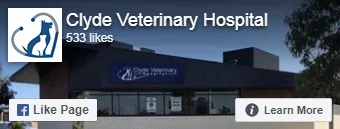Bringing Home Your New Puppy – 10 Essential Tips for New Dog Owners
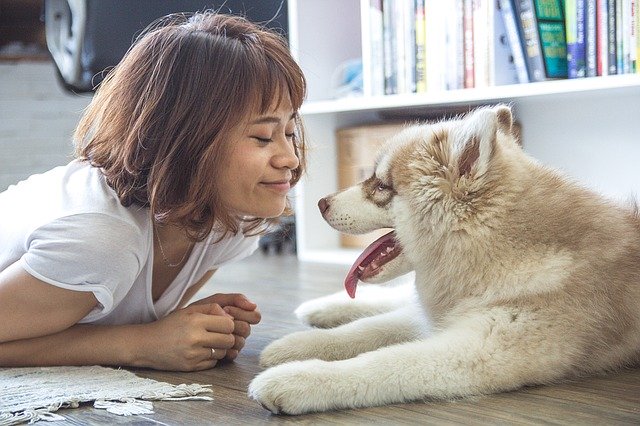
By Dr Irene Mitry
It’s an exciting, expectant time – you’ve chosen that puppy of your dreams, and in a few days they will be with you. But even if you’ve been through the joys of puppy ownership before, it’s always a good time to pause and make sure you’re ready in every way for the massive changes the new member of your family is bound to bring.
The changes can be many and surprising. The needs of a new puppy can be highly variable based on their breed, temperament, and even on their age.
So I thought it would put together this handy guide for new puppy owners, walking you through some of the best tips and advice for preparing for your new puppy’s arrival and their early days in your care.
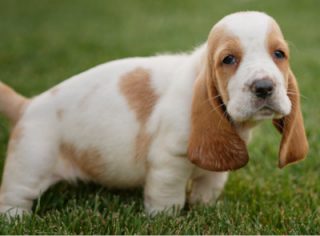
BEFORE THEY ARRIVE
1. Educate Yourself
We recommend that you take the time to read up as much as possible on all aspects of puppy behaviour, training, socialisation, and care – the more you know, the more prepared you will be for the inevitable curveballs that puppy ownership is occasionally going to throw at you.
The RSPCA Smart Puppy and Dog Buyer’s Guide is a great place to start your research online, and it’s full of handy tips and hints for new puppy owners at all stages of their decision-making.
Specifically, we definitely recommend doing BREED-SPECIFIC research, as the needs of the different breeds can vary widely in terms of food, exercise, and regular care needs as well as their specific behaviours and temperament. Not all dogs are suited to all homes, and a lot of sadness could be avoided by prospective owners fully researching their breed of choice well in advance of committing themselves.
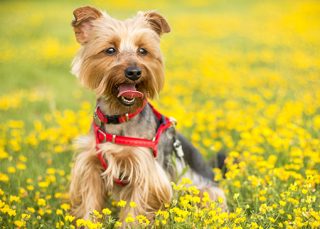
2. Set the Rules
You should set up a household meeting in advance of your new puppy’s arrival, to set a series of rules that everyone can clearly understand, and agrees to follow. It’s not fair for them to change the rules once they have already ‘settled in’. Rewarding your dog when it abides by these rules will make it worthwhile for the dog to continue obeying them.
Topics for discussion may include;
- Where will your new puppy be allowed? Will there be any out of bounds areas?
- Whose responsibility will feeding your puppy be? Will you use a roster?
- Who will walk/train them?
- Where will they sleep?
- Where will they be allowed to go to the toilet?
You should all already have agreed on a name to use for your new puppy. The family should agree to call your puppy only by this new name – no abbreviations or nicknames until they are properly socialised.
You should also take the time to create a vocabulary list of commands that everyone will use. If Mom says “down” when your puppy climbs on the couch, Dad says “down” when he wants the dog to lie down, and Junior says “sit down” when he expects them to sit, all you are going to create is a confused rather than an obedient new pet.
If there are children in the household, teach them how to hold and play with the new puppy. Make sure that they know that rough-housing, poking, and ear pulling aren’t allowed. Children younger than six should be taught that they must always be sitting on the floor when holding the pup to make sure that it won’t be injured if it’s dropped. Use a stuffed toy to demonstrate if possible.
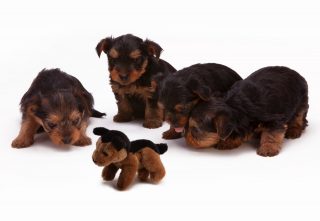
3. Do Your Shopping In Advance
The following should serve as a rough checklist of items that you may need to purchase in advance of your new puppy arriving on your doorstep. Not all of them will be essential for all dogs, but by using this list you can be sure you won’t be caught surprised with any of their needs.
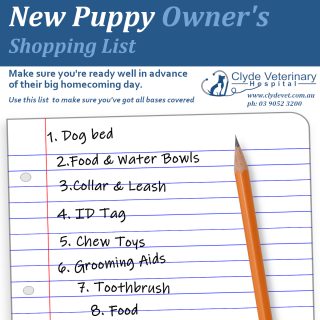
- Dog Bed – be sure you look for one big enough to easily accommodate your puppy’s early growth, but which is going to provide them with enough comfort and snugness particularly in winter. A full-size dog bed will almost certainly be too large for them in their first year (particularly beds designed for larger breeds)
You may have been given a traveling crate to bring your puppy or dog home in. And as long as the crate’s big enough for your puppy or dog to turn around in comfortably, it’s great for indoor use as well. Dogs hate to go to the toilet in their own bed, so a crate is a great toilet-training aid in those first few weeks when your puppy or dog is adjusting to their new routine. You can also use it to take them in the car to explore new sights and sounds. At night, put your puppy or dog to bed in their crate and, as long as you let them out at suitable intervals, they won’t urinate or defecate on the floor. - Food and Water Bowls – Choose heavy-bottomed ceramic or stainless steel food and water bowls. Plastic bowls can wind up as chew toys and attract bacteria. A heavy bowl will also be harder for your dog (and you) to knock over by accident.
- Dog Collar and Leash or Harness – You won’t be taking your new puppy out for walks until they have had all their proper vaccinations, but you can spend this time getting them used to wearing and walking with their collar and a lead. Nylon or soft leather adjustable collars are recommended, as they’ll grow with your puppy. Adjust the buckle so that you can comfortably put a couple of fingers between the collar and your puppy or dog’s neck, and be sure to check the fit regularly; as you’ll be amazed at how fast they grow. If you have a very small dog, like a small terrier or a toy breed you might prefer to use a dog harness instead, which helps protect the delicate necks of smaller breeds.
- ID Tag – they are never more likely to stray from in your home than in those early days. As well as making sure your property is properly escape-proof, it’s a good precaution to arrange for an ID tag to attach to their collar, showing your name, address and phone number too, so they can be easily returned to you if they do stray.
- Chew Toys – Dogs love chewing and a teething puppy will chew anything they can get their jaws around. So if you want to protect your socks and other household items, buy a selection of chew toys for your puppy to test their teeth on instead. Make sure they’re non-toxic, durable and not too tough for puppy teeth. And never leave your puppy alone with anything that could choke them, splinter in their mouth or electrocute them.
- Grooming aids – Grooming your puppy is about much more than just good looks and hygiene – it’s also a bonding experience between you and your dog that reminds them of being back with their mother. Speak to your groomer about picking up a comb or a brush and plan daily grooming sessions. Different types of brushes are available for different coat types, so make sure you do your research or ask your groomer what type of brush is most suitable for your puppy. You’ll also need to clip your dog’s nails from time to time, so it’s worth picking up a suitable pair of nail clippers for your dog’s size.
- Toothbrush – Dental hygeine can be a major issue for dogs as they age, and we recommend getting them used to the regular use of a dedicated pet toothbrush or finger brush from the earliest possible age.
- Food – It may seem obvious, but the last thing you want is to get your eager young pup home and forget to cater for their always present appetite. We discuss specific puppy dietary needs below, but you should have an appropriate dry and wet food available for them on their first day in their new home. It’s a good idea to try and find out what food they have been eating in their previous home, in order to minimise the change in the new environment.
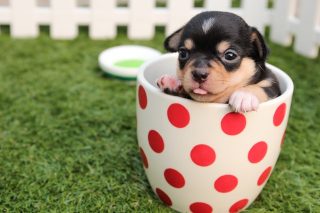
4. Puppy-proof Your House
Most young puppies love to chew on anything they can wrap their chops around. It’s how they learn to relate to the world around them, and they’re going to be inquisitive about most new objects they come across.
For this reason, it’s important that you keep any objects that are not specifically intended as chew toys totally out of reach of your inquiring young pup.
Stairs, balconies, ponds, and pools should all be out of bounds for an inquisitive puppy. A strategically placed baby stair gate can be effective for setting the boundaries whenever you’re not there to supervise. Baby gates can also serve to protect your furniture or other items from Pupper’s over-attentive teeth.
Puppies are clumsy and have fragile bones, so a seat on the couch or in a standing child’s arms puts them at risk of injury if they fall or try to jump. It’s best to keep your puppy off tall furniture and have young children sit when holding them until your puppy is less fragile and more coordinated.
You’ll want to do a complete audit of your entire home, looking for ANY potential risks or escape points. The following list is not exhaustive, but a good checklist to make sure you have all of the most common risks to your new puppy covered.
- Make sure your rubbish bin is secure – there are all sorts of hazardous nasties lurking in there, and a million fascinating smells to make the bin a place of supreme interest to puppies as well. Try and keep a fully lidded bin in a location that will be inaccessible to your dog.
- Secure electrical leads – protect your new puppy from accidental shock, burns to the mouth, or worse, by using sturdy cord covers or deterrent sprays on electric cords, chargers, and power cables.
- Secure Household Poisons – from rat poison, slug bait, household cleaners and detergents, types of antifreeze and glues, to yard and automotive chemicals, you’ll be amazed once you start to check just how many potentially risky substances you may have around the home, and many safety caps won’t stand up against those sharp puppy teeth. For that reason we recommend that you keep all such substances well out of reach of your dog, and ideally in some sort of secured cabinet. Make sure all your family members are aware of which substances are hazardous so everyone knows not to leave them lying around.
- Remove loose medications – medications left lying around the house are one of the most common causes of pet poisoning. Make sure you store all your medications insecure, inaccessible locations.
- Check for poisonous houseplants – several common houseplants can cause serious problems, from mild irritation and digestive upset to organ failure and even death if your puppy decides to take a nibble. Some of the most dangerous plants for dogs include many common species of Cycads, Castor Bean and the Autumn Crocus. We recommend checking the ASPCA’s list of poisonous plants and flowers to see if you have any potentially dangerous plants around your home which should be removed.

AFTER THEY ARRIVE
5. Bringing Your New Puppy Home
Ideally, bring your puppy home when you will be at home for at least a few days to supervise them and quickly observe any medical problems should they develop.
It will probably be the first ever car ride for your pup. They will probably not enjoy the experience too much, and the stress of it all can cause an upset tummy. If possible, ask the breeder not to feed your pup for about two hours before their big trip.
If you’re picking up your puppy directly from a breeder, it’s a great idea to take a brand new toy or new blanket and rub it on each of the puppies in the litter or on the bedding that the puppy slept on. This will put the ‘scent of the litter’ onto the toy or blanket, which you should then place in your puppy’s bed when it is time to sleep. It will provide the puppy with some familiar smells on its first night when it may be missing its siblings.
Transport your puppy in a dog crate or travel box with a blanket at the bottom. It should be kept secure in the vehicle and not left sitting loose on a seat where it can easily fall off. If possible, take a second person with you in the car to keep the puppy company. As soon as you arrive at your destination, let your puppy relieve themselves on the grass before going inside.
Quickly introduce your puppy carefully to all members of the family, but don’t overwhelm them with loud noises and lots of activities. Close off doors to other rooms and keep the pup contained initially in just one area where it will be fully supervised.
Allow the puppy to explore the room and then to meet his new family in a calm and quiet manner. Take the lead from the puppy as to whether it wants to be cuddled or played with or even have a nap.
When first introducing the pup to other household pets or adult dogs, it’s a good idea to have a second person around so that both adult dog and puppy can be kept on a lead and restrained when first introduced. Watch for body language and signs of aggression which might be staring, baring teeth, laid-back ears or raised hair on the back of the neck. If this happens, remove one of the dogs and let them both cool off and try introducing them again later. If there’s more than one adult dog, introduce them one at a time.
When introducing a cat to a puppy, make sure that the cat has an escape route. The cat will always feel safer if it has a ‘puppy free’ zone where it can relax without fear of being pestered or chased.
Other cats and dogs should never be left alone with the puppy or be allowed to sleep with it until you are sure that there is no potential for aggressive behaviour. And, don’t expect them to be best friends overnight as they will all be trying to work out where this ‘intruder’ fits into the pack.
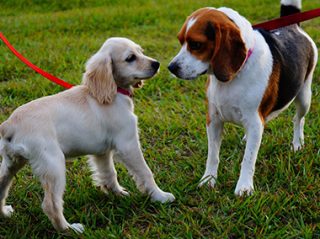
6. Training and Exercise
Puppies have what is known as a ‘critical socialisation period’ that occurs between approximately 3-17 weeks of age, when they do most of their emotional development and learn how to interact with the world around them.
Providing plenty of opportunities for socialisation and exposure to different environments during this time can help to ensure your puppy grows into a well-adjusted adult that relates well to other dogs, other animals, and people.
The best way to begin socialising your puppy is to enroll them in reward-based puppy school classes, such as those offered here at Clyde Veterinary Hospital.
Reward-based training using positive reinforcement is the most effective and humane way to train and socialise dogs. This involves the animal being rewarded when the desired behaviour is performed and any unwanted behaviour is ignored.
Rewards can take a physical form (such as a treat or dog chew) or a more emotional one. Just hearing their name spoken with enthusiasm and positivity, telling them they are a “good boy/girl”, reinforced by a quick pat is a rewarding experience for your dog – just be careful about overdoing the edible treats.
Training based on painful or unpleasant stimuli, dominance, force or punishment should not be used, as they can cause long-term behavioural problems in dogs.
Talk to your vet about when you can safely take your pup for walks to different locations to get it used to a variety of people, places and other animals in relation to their vaccination status.
A walk is often their favourite part of the day and an important part of their obedience training. Exercise also provides various physical health benefits and a good opportunity for your dog to socialise with other dogs.
It is important to avoid over-exercising your puppy, and puppies need much less exercise than fully-grown dogs. A good rule of thumb is a ratio of five minutes of exercise per month of age (up to twice a day) until the puppy is fully grown.
Over-exercising a growing puppy can overtire it and damage their developing joints, leading to early arthritis. You should also never exercise your puppy on a full stomach as this can contribute to bloat.
Your new puppy will be learning firstly about how to behave on a lead, and you should only consider letting them roam in an off-leash area once they have proven their responsiveness to basic commands – most particularly that they will come to you when called.
It’s recommended letting your pup wear their collar or harness and leash indoors for a period, in order to become accustomed to the sensation before introducing them to the big world outside, and making the experience less overwhelming.
If your puppy is constantly pulling at the leash, we recommend owners turn themselves into a “tree”, that is become an immovable object and do not recommence the walk until your dog has returned to you. If they tend to “lunge” at other animals, you need to be more proactive in your interventions by physically restraining them and if possible distracting them from the other animal.
It’s recommended starting out your walks with a number of treats for your dog to reward any positive behaviours and distract them from the potential threat of other animals. Over time, as your puppy learns these reinforced behaviours, you can then reduce their dependence on treats for obedience.
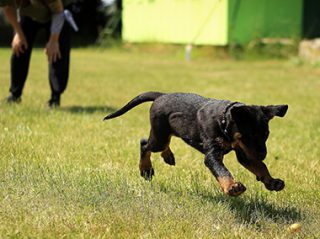
7. Toilet Training
Experts recommend that you begin toilet training your puppy when they are between 12 weeks and 16 weeks old.
Toilet training takes time and patience. If you need to break existing bad habits, the process can take up to a year, but 4-6 months is most common.
To make the process of toilet training successful and as efficient as possible, you need to use reward-based positive reinforcement training, and we recommend observing the following best practices;
- Keep your puppy on a regular feeding schedule and take away his food between meals.
- Take puppy out to eliminate first thing in the morning and then once every 30 minutes to an hour. Also, always take him outside after meals or when he wakes from a nap. Make sure he goes out last thing at night and before he’s left alone.
- Take the puppy to the same spot each time to do his business. His scent will prompt him to go.
- Stay with him outside, at least until he’s house trained.
- When your puppy eliminates outside, praise him or give him a treat. A walk around the neighborhood can act as a nice reward.

8. Puppy Diet and Nutrition
Puppies have a high nutritional demand and can’t go for long without food. It’s very important to feed them small meals regularly, ideally 3-4 times a day if possible.
When you pick up your pup, remember to ask what and when he was fed. Try and replicate that schedule for at least the first few days if possible, to avoid gastric distress.
Introduce the new diet you wish to feed them in small incremental stages over a few weeks – adding one part new food to three parts of the old for several days; then switch to equal parts; and then one part old to three parts new, until you are feeding your pup your preferred diet completely.
Your vet can advise on your puppy’s best diet based on their unique circumstances, but in general, the best food to feed them is a high-quality commercial kibble designed for puppies (age and breed). This ensures all the necessary nutrients for your puppy’s growth and development are present.
You can add cooked meats and vegetables or rice as you wish; however, the main diet should be the commercially balanced kibble.
Raw diets are not recommended for very young pups as they don’t have the immune system development to cope with a high bacterial load. It is also very difficult to balance a raw diet for growing puppies.
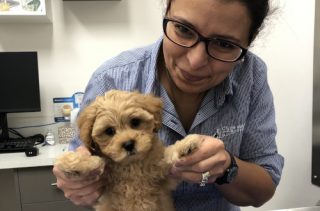
9. Vet and Council
We recommend you schedule your puppy’s first trip to the vet as soon as possible. Puppies are vulnerable to a host of infectious diseases – some of which can be fatal, and so getting them on a vaccination program as soon as possible is your best bet to guard against the most common such conditions.
Your vet can also provide contextual diet and behaviour advice and answer any specific questions about your puppy’s rearing and behaviour, and talk to you about flea treatment, worming, and other essentials.
Dog owners in Victoria are legally required to have their dog microchipped and to be registered with the local council, as well as ensuring the dog is kept securely on your property. Local councils may also have additional requirements such as having the dog desexed (or granted an exemption from desexing) prior to allowing their registration.
The City of Casey requires animals to be desexed or exempted prior to registration, and owners of more than 2 dogs or cats should note that Council may require you to seek a permit to keep excess animals or livestock.
Find out more information about the City of Casey’s requirements and register your pet online here.
Desexing your dog prevents unplanned pregnancy and has some positive effects on behaviour and health. Desexed animals are less likely to wander or fight over territory thereby reducing the likelihood of car injuries and bite wounds. Desexing also significantly reduces the risk of some common reproductive cancers and other serious diseases.
Unless you have a strong imperative such as future breeding, we strongly recommend having your puppy desexed at the earliest possible opportunity.

10. Leaving Them Alone
Your puppy will require a lot of care and attention from you. At some stage, however, you may have to leave your puppy alone for short periods. Try and make this a gradual process to avoid creating anxiety for a puppy – try leaving initially for very short amounts of time, if possible and reward your pup upon returning with a healthy dog food treat, a walk or playtime. Gradually increase the length of time you are away so that your puppy realises that you will always come back and he will have a walk to look forward to.
A good way to avoid boredom while you are away is to leave toys for your puppy to play with. Keep a stash of toys hidden and give your pup different toys to play with on different days. Safe dog toys that can be filled with healthy doggie treats can help to keep him entertained while you are away.
If possible, try and keep any “out of bounds” areas properly fenced off to ensure your puppy learns that the rules are in place, whether they are under observation or not.
You can also try taking your puppy for a walk immediately before you leave, as this can help to tire out dogs before they are left alone. Remember to avoid feeding immediately before or after exercise.
SUMMING IT ALL UP
In short, you can never do too much preparation or planning for welcoming a new puppy into your home – and everyone should be involved in the planning and rule-setting.
Once they have arrived, try and make the most of their critical socialisation period in order to avoid behavioural problems down the track. Try and give them as much stimulation from as many different environments as possible. And remember to always reward with positive reinforcement and try to ignore rather than punish unwanted behaviour.
And you’ll want to get them along to the vet as soon as possible to put a comprehensive vaccination, desexing and microchipping regime in place. Don’t forget at Clyde Veterinary Hospital, your new puppy’s first health check is completely free – pay $0 consultation fee for their first visit. CLICK HERE for more information


